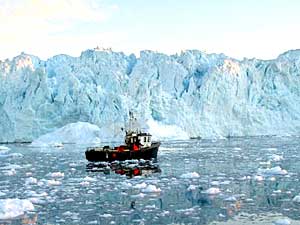|
Audio
Photos
Resources
Your Voice
|
Scientists say Arctic region bearing the brunt of climate changes
November 8, 2004
Washington D.C. — (AP) - Scientists say changes in the earth's climate from human influences are occurring particularly intensely in the Arctic region, evidenced by widespread melting of glaciers, thinning sea ice and rising permafrost temperatures.
 | |||
A study released Monday said the annual average amount of sea ice in the Arctic has decreased about 8 percent in the past 30 years, resulting in the loss of 386,100 square miles of sea ice - an area bigger than Texas and Arizona combined.
"The polar regions are essentially the earth's air conditioner," Michael McCracken, president of the International Association of Meteorology and Atmospheric Sciences, told a news conference Monday. "Imagine the earth having a less efficient air conditioner."
Susan Joy Hassol, the report's lead author, said the Arctic probably would warm twice as much as the Earth. A region of extreme light and temperature changes, the Arctic's surfaces of ice, ocean water, vegetation and soil are important in reflecting the sun's heat.
Pointing to the report as a clear signal that global warming is real, Sens. John McCain, R-Ariz., and Joe Lieberman, D-Conn., said the "dire consequences" of warming in the Arctic underscore the need for their proposal to require U.S. cuts in emissions of carbon dioxide and other heat-trapping greenhouse gases. President Bush has rejected that approach.
 | |||
James Connaughton, chairman of the White House Council on Environmental Quality, said the Bush administration is spending $10 billion yearly on research into climate change and related issues. "The president's strategy on climate change is quite detailed," he said.
In the past 50 years, average yearly temperatures in Alaska and Siberia rose about 3.6 degrees to 5.4 degrees Fahrenheit, and winters in Alaska and western Canada warmed an average of 5 degrees to 7 degrees Fahrenheit.
With "some of the most rapid and severe climate change on earth," the Arctic regions' melting contributed to sea levels rising globally by an average of about three inches in the past 20 years, the report said. Sea levels globally already are expected to rise between another four inches to three feet or more this century.
 | |||
"These changes in the Arctic provide an early indication of the environmental and societal significance of global warming," says the Arctic Climate Impact Assessment, a four-year study by 300 scientists in eight Arctic-bordering nations, including the United States.
This most comprehensive study of Arctic warming to date adds yet more impetus to the projections by many of the world's climate scientists that there will be a steady rise in global temperature as the result of greenhouse gases released into the atmosphere from the burning of fossil fuels and other sources.
It is based on ice core samples and other evidence of climate conditions such as on-the-ground and satellite measurements of surface air temperatures. Nations participating in the study besides the United States are Canada, Denmark, Finland, Iceland, Norway, Russia and Sweden.
"The bottom line is that the Arctic is warming now, much more rapidly than the rest of the globe, and it's impacting people directly," said Robert Corell, chairman of the scientists' study panel and a senior fellow with the American Meteorological Society.
 | |||
The process is only likely to accelerate in the Arctic, a region that provides important resources such as oil, gas and fish, the study finds.
That would wreak havoc on polar bears, ice-dependent seals, caribou and reindeer herds - and local people such as Inuit whose main food source comes from hunting those animals. Some endangered migratory birds are projected to lose more than half their breeding areas.
The study projects that in the next 100 years the yearly average temperatures will increase by 7 to 13 degrees Fahrenheit over land and 13 to 18 degrees over the ocean, mainly because the water absorbs more heat.
Forests would expand into Arctic tundra, which in turn would expand into polar ice deserts since rising temperatures favor taller, denser vegetation. Arctic tundra would shrink to its smallest extent since 21,000 years ago when humans began emerging from an Ice Age.
(Copyright 2004 by The Associated Press. All Rights Reserved.)
|
News Headlines
|
Related Subjects
|

